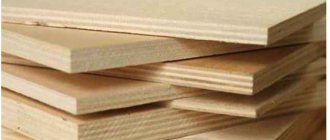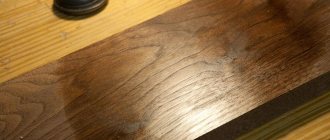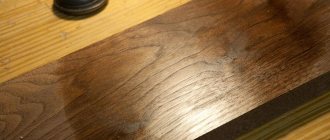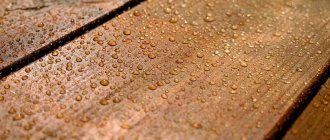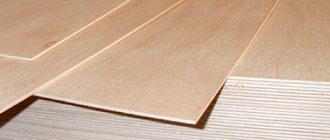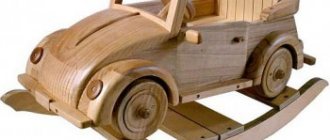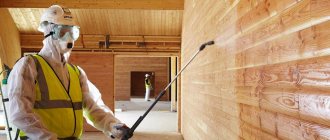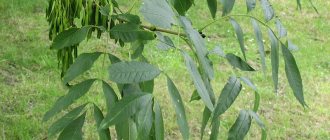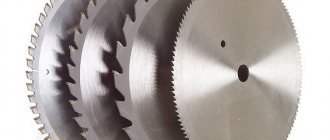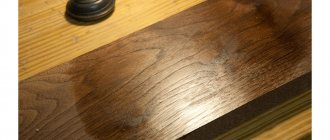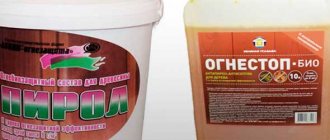Wood varnish: definition, features, history
Varnishes are commonly called viscous solutions that are applied to the surface in an even layer and, after drying, form a durable film that can have a strong or light shine (depending on the type of varnish).
A monk named Theophilus, who lived in Germany in the 12th century and kept the recipe for his invention strictly secret, began to use varnish coating for the first time. Many years later, historians managed to find out that its basis was alcohol. Then, in the 15th-17th centuries, oil-type varnishes, produced exclusively in England, were used everywhere (the monopolists also kept the recipe secret).
Mass production of varnishes began only in the second half of the 18th century, after the appearance of a detailed treatise on them written by a French chemist. This was facilitated by the emergence of new raw materials - resins, delivered from Portugal and Holland. In Russia, the Osovetsky plant in Moscow was one of the first to produce varnishes (high-grade oil-based). This was in 1874.
Since then, the variety of varnish coatings has increased significantly. Each of them has its own type of film former and performance characteristics.
How to choose the right product
Everyone's selection criteria are different. Some are interested in minimal consumption, others are interested in UV protection, others purchase the best products after first reviewing reviews and studying the ratings of quality products. It is impossible to say for sure which company has the best product. It all depends on the personal preferences of the master. When choosing a composition, experts recommend paying special attention to the following nuances:
- Terms of Use. The street requires constant temperature changes, high humidity, ultraviolet radiation, dust, dirt, and mechanical damage. According to buyers, it is necessary to approach the composition of the product with full responsibility. Information about the scope of use of the product is indicated by the manufacturer on the packaging. The walls of houses and other buildings are coated with a composition for exterior use, while furniture, interior doors, and parquet can be covered with products for interior use.
- Wear resistance. The indicator plays a big role depending on the processing material. If we are talking about furniture, then it is enough to opt for unstable nitrocellulose varnish. Flooring requires the use of high-quality products with increased wear resistance.
- Toxicity. Due to the presence of organic compounds in the composition, most manufactured models have a sharp, unpleasant odor that remains for a long time until the layer dries completely. Then it disappears. This “aroma” can lead to headaches, nausea, allergic reactions, poisoning, and deterioration in the general health of residents. It is especially harmful for children and the elderly. When working with acrylic, polyester, polyurethane and nitro varnishes, special protective equipment is required. After complete drying, the danger goes away. For interior work, such compositions can be used only in cases where no one will live in the house during the drying period. If household members have nowhere to go, it is worth purchasing less toxic water-based products.
- Resistance to elevated temperatures. There is such a characteristic as heat resistance. Products with such data are used in facilities with an increased risk of fire. Not only a special composition is required, but also the correct application.
- Drying period. The average time for complete drying ranges from 6 to 72 hours. Some models take much longer to dry - up to three weeks. These include oil-based and water-based products. For nitrocellulose and alcohol varnishes, wait 20 minutes. Based on this criterion, products of this type are divided into quick-drying and slow-drying. This characteristic must be taken into account when carrying out construction or repair work under short deadlines.
- Components. One-component formulations are suitable for household use. Professionals prefer to work with two-component products. They have increased durability and a long service life.
- The need for a primer. A large number of products are produced. One can be safely applied to unprepared wood, the other requires special pre-treatment of the surface (primer). If manipulations are not carried out, the varnish will begin to peel off quickly and become covered with cracks and craters.
- Shine. When opened with varnish, a matte or glossy surface is obtained. The choice depends on the aesthetic preferences of the person. Gloss visually expands the space, while a matte finish adds charm to the surface and emphasizes the natural beauty of wood. The degree of gloss is indicated as a percentage. A high-gloss product has a degree of light reflection of 90%, glossy - from 80 to 90%, matte - no more than 10%. Semi-gloss and semi-matte products are available on sale.
Oil (or oil-resin) varnishes
Characteristics:
- Drying time is from 24 to 72 hours.
- The ability to penetrate into wood is high.
- Composition: oil and resin. Depending on the oil content, they can be lean, oily or medium. Increasing the amount of resin speeds up drying, but reduces the strength of the coating and its ability to withstand weathering.
Application:
Today, PF-283 brand varnish has replaced S-4 (produced since the middle of the last century). Intended for interior work only. Apply to furniture and other wood products. Not suitable for floors.
Application methods
Like other paintwork materials, varnishes, depending on the viscosity, can be applied using a brush, roller or spray. Before starting work, the surface of the base is thoroughly cleaned and sanded. Many compounds, especially two-component epoxy, as well as polyurethane, are very sensitive to high humidity at the time of application. Therefore, you need to avoid getting water on the work surface.
Some paintwork materials require pre-coating with primer or special primer varnishes. It is strongly recommended to use primer from the same manufacturer. Water-soluble varnishes can be used as a primer, after being diluted with water within 10-25% of the total volume. The use of a special primer can significantly reduce the consumption of more expensive finishing decorative mixtures.
Applying varnish using a spatula is a rather complicated procedure that is best left to professionals PHOTO: chudopol.ru
There is a specific method for applying viscous varnishes - with a spatula. Its use allows you to reduce consumption several times and create a perfectly smooth surface without fluff and traces of strokes.
Resin varnishes
Characteristics:
- They may be based on natural resin (amber, for example); thermoplastic resin (synthetic); thermosetting resin (synthetic).
Application:
Used for the same purposes as oil varnishes.
Alkyd varnishes
Characteristics:
- Composition: alkyd resin, drier (accelerating drying) and petroleum solvent (solvent or white spirit). PF – pentaphthalic varnishes, GF – glyphthalic varnishes.
- Moisture resistance and resistance to temperature changes are high.
- The price is low.
- Drying time – up to 48 hours.
- The service life of the film on the floor is 2-3 years.
Application:
Covering parquet (including heated, end, and also made from capricious wood) and floating floors, furniture.
The difference between varnish for interior and exterior use
Many people are accustomed to using wood varnish for interior work. This is an excellent material that also protects the tree, gives it beauty and extends its service life. There are a huge number of such compounds in stores.
All paint and varnish materials can be divided into different categories. One of them is the scope or terms of use. Therefore, there is a varnish for interior woodwork and a varnish for exterior woodwork. What's the difference? It's all about the environment and the influence that is exerted on the tree. The material inside is in favorable conditions. But as for outdoor products, they are subject to negative influence. This includes:
- temperature changes;
- precipitation, in the form of snow, rain, fog;
- direct influence of sunlight;
- thermal expansion of wood;
- mechanical impact.
This means that varnishes for exterior use must resist all these negative factors. If you use regular varnish outdoors, it will very soon become unusable. Due to their properties, varnishes for outdoor use can last a long time in this environment. After application, an elastic film is formed, which will allow the wood to withstand constant drying and swelling. Varnishes for interior work cannot boast of such elasticity. They will immediately peel off and crack.
Note! The colors of wood varnish can be very different, to suit every taste and color. Everyone can choose a color to their liking so that the surface being treated matches other elements. Wood varnish for interior color.
If the use of varnishes for interior work is limited to certain surfaces, steps and furniture elements, then the scope of use of varnish for exterior work is much larger. They can treat the following surfaces:
- Terrace, wooden steps, porch.
- Part of the roof.
- Processing of wooden fences.
- The facade of the house is made of wood.
- Walls of baths and other similar buildings.
- Garden furniture and wooden sculptures (crafts, wooden flower beds, etc.).
- Entrance wooden door.
As you can see, it is a versatile material, which can make the use of wooden structures even better. With varnish, the wood will look better and last longer. But in order to do all this, the paint and varnish material must meet certain characteristics. What are they? Let's find out.
Alcohol varnishes or polishes
Characteristics:
- Composition: ethyl alcohol and resin dissolved in it (from 30 to 35%).
- The price is low.
- Drying time is from 20 minutes to half an hour.
Application:
Coating of furniture, musical instruments, leather and glass products. A special type of such products (shellac) is used for decoupage.
Recommendations for applying varnish
The varnish must be applied to dry wood. If it rained the day before work, it is better to postpone varnishing and wait until the wood is completely dry. The moisture content of coniferous wood during painting should not exceed 15%; for hardwood this figure is 12%.
Regardless of the means used to varnish the facade, varnishing the timber outside the house must be done in calm and dry weather. The street temperature should be at least 10 degrees, and the optimal values are 15-25 degrees with a humidity of about 80%.
Before varnishing, the surface must be carefully prepared:
- clean the facade from dirt and dust;
- remove the previous paintwork;
- sand the wood well;
- apply two layers of antiseptic on the walls and 3-4 layers on the ends of the timber to protect the wood from rotting and microorganisms;
- treat the house with fire retardants to prevent fire;
- prime the surface.
When diluting varnish, it is necessary to take into account its type.
As a rule, paintwork materials are mixed with a solvent. Only water can be added to acrylic products. Yacht varnish is generally not recommended to be diluted. It is more convenient to apply varnish to the facade of a building with a spray bottle, in this case the composition will evenly cover the surface. It is better to treat edges and hard-to-reach areas with a brush with mixed bristles. For oil composition it is recommended to use a natural brush.
Before varnishing the lining outside the house, you should test it for adhesion, decorative characteristics and color of the future coating. To do this, apply the product to a small, inconspicuous area. After the composition has dried, try removing it with a spatula. If the coating is difficult to remove, this indicates good adhesion of the materials. If the spatula leaves deep marks, the surface needs to be primed again.
To get a beautiful and durable coating, you need to apply at least two layers of varnish. If porous wood is painted, the surface is varnished at least three times. After each layer has dried, it is recommended to perform intermediate sanding with fine-grained sandpaper.
Alkyd-urea varnishes
Characteristics:
- Composition: alkyd resin (glyphthalic or pentaphthalic) and urea.
- Type – two-component (ready for use only after adding an acid hardener).
- Strength and moisture resistance are high.
- The shine is strong.
Application:
For covering floors or parquet, as well as other wooden products. An example is varnish MCH-063.
Correct work with paintwork materials
Basically, special odorless paint is used to treat planed or parquet boards, however, some experts recommend using varnish for wooden surfaces for these purposes. In order to carry out high-quality varnishing of wooden products, pay attention to the simple instructions below.
Surface preparation. If the surface to be treated has not been varnished before, it should be thoroughly treated before applying the coating. If there is an old varnish coating, you just need to apply a new layer of varnish on top. Treatment of a wooden surface before varnishing involves thoroughly sanding the wood. After sanding, you need to remove dust from the surface, preferably with a vacuum cleaner, and you can move on to the next stage.
Varnishing. Applying varnish to a cleaned wooden surface is done with a brush, roller or paint sprayer. Quite often, after processing, light wood becomes darker, while dark wood, on the contrary, turns yellow or redder. As a rule, such a change in the color of the wood occurs immediately after applying the varnish. Therefore, it is worth finding out in advance the properties of the composition used.
Different wood has its own hardness, which, in turn, determines the required number of coating layers. Soft woods, such as pine or spruce, require 3-4 layers of varnish, while harder wood requires two. If an alkyd composition is used, then 10% white spirit must be added to apply the first layer.
Epoxy varnishes
Characteristics:
- Type – two-component.
- Film former – epoxy resin.
- Hardness, impact resistance and water resistance are high.
Application:
Used for application on doors, parquet, solid floors. In general, when deciding how to choose a varnish for wood that experiences high loads, this type is usually chosen. An example is varnish EP-2146.
Difficulties in choosing wood varnish
To select the appropriate type of varnish that would meet the required tasks, you should use the following simple rules:
- Before starting work, it is necessary to assess the surface that needs to be treated, as well as determine the requirements for its future performance;
- Assess the future volume of work - if the scope of upcoming work is large and the budget is relatively small, then you should opt for inexpensive oil varnishes, however, you will have to sacrifice an increase in working time and a decrease in quality;
- Otherwise, when work time is limited, it is worth choosing varnishes that have quick-drying properties;
- If the tasks ahead are standard and do not require, for example, decorative work, then the varnish can be chosen from the category of universal ones;
- The issue of saving should not be a priority if the buyer has health problems (the selection of hypoallergenic varnishes without unpleasant odors is required) or when the work involves performing decorative and artistic tasks, which will require careful selection of the shade of the varnish;
- Before starting work, it is necessary to make cost calculations, in which it is necessary to take into account the area of the surface to be painted, the number of future layers of application, approximate price limits in retail chains for various types of varnishes, and the quality characteristics of various types of mixtures.
Cellulose essential (nitrocellulose) varnishes
Characteristics:
- Ingredients: organic solvent, cellulose nitrate, resins, plasticizers.
- Drying time is from 20 to 50 minutes.
- Weather resistance is low.
- Water resistance – high.
- Polishing ability is excellent.
- Durability – average (over time the coating peels off).
Application:
Used for applying to pencils and musical instruments. Examples are glossy varnish NTs-218 and matte varnish NTs-243.
Video description
You can see how to properly varnish wood in the video
A few tips and recommendations will help you in your work:
- Usually the varnish is applied in several layers, at least 3 – primer and 2 layers of varnish.
- The composition must be applied by brushing or rolling along the wood grain. This will help avoid noticeable streaks. The varnish is applied vertically with short cross strokes.
- You need to apply the mixture quickly, as most varnishes begin to dry immediately.
- After the first coat is applied, it is left to dry, then sanded with 120-grit sandpaper. This is done to remove strong streaks and ends of wood fibers that may have risen when wet and dried.
- After sanding, the surface is cleaned of dust and wiped with a damp cloth to completely remove dust.
- Then a second layer is applied to a clean and dry surface. If necessary, after it dries, repeat sanding and remove dust.
- If necessary, repeat the procedure several times. The penultimate layer is sanded with 200-400 grit sandpaper and the last layer is applied. If there is any excess left when applying it, remove it with a piece of cloth and solvent.
Acrylic urethane varnishes
Characteristics:
- Can be diluted with water.
- Almost odorless, absolutely safe.
- Adhesive properties are excellent.
- They cannot withstand temperatures below minus 5 degrees when stored. Apply at temperatures from plus 12 degrees.
Application:
Used for interior work: finishing saunas and baths, covering the sidewalls of floating parquet boards.
Why do you need to varnish a wooden surface?
Wood remains a popular building material despite some disadvantages. Wooden coverings are durable, environmentally friendly and beautiful, hypoallergenic, look good in a variety of interiors and have good heat capacity (a wooden floor doesn’t even need to be insulated).
However, natural wood has a number of disadvantages: they are more difficult to install, and disruption of the process can lead to cracks and creaking. With changes in temperature and humidity, the boards can expand and shrink, which is why gaps may appear between them or the boards will rise like a house. The tree must be protected from insects and rodents, and the protective coating, paint and varnish must be regularly updated.
When applying varnish, a thin hard film is formed on the wood, which protects against water, UV rays and pests, and allows you to eliminate minor imperfections (splinters and splinters). The varnish also helps to maintain the natural color or get a new one.
Alkyd-urethane varnishes
Characteristics:
- Composition – alkyd resin and organic solvent with a group of urethanes.
- Service life is 2 times longer than that of alkyd varnishes.
- The smell is unpleasant.
Application:
Of the many types of wood varnishes, this one is called yacht (or boat) varnish. After all, its resistance to weather changes is very high. This is the best option for covering ship surfaces.
Popular brands of varnishes and reviews of them
Now let’s study customer reviews about different brands of wood varnish.
Review of Tikkurila Euro kiri parquet varnish:
More details on Otzovik: https://otzovik.com/review_7736932.html
wood varnish Tikkurila Euro kiri
Review of Feidal Pu Parket Moebellack parquet varnish:
More details on Otzovik: https://otzovik.com/review_2711271.html
Feidal Pu Parquet Moebellack
Review of alkyd-urethane varnish Parade “Yachts & Boats”:
More details on Otzovik: https://otzovik.com/review_2424326.html
Parade "Yachts & Boats"
Review of furniture varnish V33:
More details on Otzovik: https://otzovik.com/review_6719315.html
furniture varnish V33
Review of Tikkurila “Unica Super” urethane-alkyd varnish for wooden surfaces:
More details on Otzovik: https://otzovik.com/review_2199518.html
Tikkurila "Unica Super"
Review of Tikkurila Taika Glow matte varnish with glow effect:
More details on Otzovik: https://otzovik.com/review_8220069.html
Tikkurila Taika Glow
Gallery of products treated with decorative varnishes:
PHOTO: berkem.ru
PHOTO: parket03.ru
PHOTO: i.ytimg.com
PHOTO: mmvikont.ru
Polyurethane varnishes
Characteristics:
- Includes one, two (base with hardener) or three (base with hardener and solvent) components.
- Hardening time is 2-3 weeks.
- Adhesion – increased.
- The smell is pungent and persistent.
- The hardness of the coating is very high (“diamond”).
- The resulting film provides protection from moisture, chemicals, and corrosion.
Application:
These varnishes are used to cover: garden buildings, external and internal walls of houses, ships and yachts, parquet floors.
What are there
There are a lot of popular product models. They all differ in functionality, characteristics, packaging volume, drying time, etc. To avoid mistakes when choosing, you need to understand the classification of impregnations. Depending on the surface to be coated, the following are available:
- for internal manipulations;
- for external manipulations.
The second option is characterized by wear resistance and the ability to withstand significant loads.
Based on the scope of application, products are:
| View | Description |
| Parquet | It is characterized by high wear resistance. The main purpose is to open floor surfaces. Can be used to improve the condition of doors or furniture. |
| Boat | The substance is intended for treating watercraft, but it is widely used for treating wooden structures located on the outside of the building. Not afraid of moisture and temperature changes, wind and direct ultraviolet rays. |
| Decorative works | Manufactured for internal use. Used for processing wooden fixtures, coatings and workpieces. |
| Furniture | Suitable for opening floors and furniture. |
Products vary in the number of components, and therefore they are divided into the following groups:
- Single-component. The film appears after the solvent evaporates and the remaining substance dries completely.
- Two-component. The film is the result of a chemical reaction between a hardener and a solvent. Belongs to the category of professional compositions.
Foreign and domestic manufacturers produce products with varying degrees of gloss, and therefore on store shelves you can see the following options:
- semi-gloss;
- glossy;
- high gloss;
- semi-matte;
- matte.
The degree of gloss depends on personal preferences and interior features.
Types of products by composition
All produced substances differ in the type of solvent, and therefore they are divided into large groups. Let's look at each in more detail.
- Alkyd
Ideal for application on parquet, including those with heating function, furniture and floating floors. They are characterized by high moisture resistance. Withstands significant temperature changes. The products consist of petroleum solvent, drier and alkyd resin. You can purchase it at specialized retail outlets or order it online in an online store. Drying time is within two days. The film remains on the surface for up to 3 years. They are inexpensive.
- Oily
The second name is oil-resin. It will take 24-72 hours for complete hardening. They have a high ability to penetrate into coatings. The composition contains resin and oil. Based on the percentage of oil content, the following types are distinguished: fatty, lean and medium. The more resin, the faster the drying. However, the strength indicator decreases noticeably. Such a coating may not withstand strong atmospheric influences. They are used exclusively for indoor work. Allows you to improve the appearance of furniture, doors, window frames. Cannot be used on floor coverings.
- Resin
The scope of use is similar to that of oily substances. The base consists of natural resin (amber), thermoplastic resin (synthetic) and thermosetting synthetic resin. Which one is better to buy depends on personal preference.
- Alcohol (varnishes)
Contains ethyl alcohol and resin. A budget option. The optimal solution for tidying up furniture and wooden musical instruments. Able to dry completely in half an hour. Shellac products are used for decoupage purposes. Suitable for use on glass and leather.
- Epoxy
Belongs to the two-component category. Epoxy resin acts as a film former. It differs from its counterparts in water resistance, hardness, and durability. Not afraid of blows. Suitable for processing solid floors, parquet, doors. Will help wooden structures withstand significant loads. The EP-2146 model is very popular among domestic craftsmen.
- Alkyd-urea
Consists of the following components:
- urea;
- alkyd resin (pentaphthalic or glyphthalic).
Belongs to the two-component type. Can only be used after adding an acid hardener to the substance. Distinctive properties are high moisture resistance and strength. What to look for when purchasing? For high shine. Designed for opening wooden objects, parquet and floors. An excellent example is MCH-063.
- Acrylic - urethane
Water-soluble substance. There is practically no smell. It is completely safe for others. It is very popular due to its excellent adhesive characteristics. Must be stored in a warm and dry place. At a frost of 5 degrees it loses its original qualities. Application is provided at a temperature not lower than 12 degrees Celsius. Designed exclusively for interior work. Ideal for finishing baths and saunas.
- Polyester
Professional multi-component compositions. The base is polyester resin. Apply using a special gun. The result is a transparent, shiny and thick film, characterized by heat resistance and resistance to chemical components and high humidity. Area of application: improving the appearance of musical instruments, furniture, and other wooden utensils.
- Alkyd-urethane
A distinctive feature is excellent performance characteristics and a long service life. There is an organic type solvent with a group of urethanes and an alkyd resin. “Fragrance” is not for everyone. The products are called boat or yacht products due to their significant resistance to weather conditions. Ideal for outdoor use.
- Cellulose ether (nitrocellulose)
The product contains an organic solvent, resins, cellulose nitrate, and various plasticizers. 20 - 520 minutes are enough for the layer to dry completely. Resistance to atmospheric conditions is low, although it can easily tolerate high humidity. Excellent polishing ability is noted. It cannot boast of durability; some time passes and the product may begin to peel off. The products are often used to open musical instruments.
- Polyurethane
Available in one, two or three components. It can be based on a hardener alone or together with a solvent. Hardening occurs after two to three weeks. Features increased adhesion. It has a persistent and pungent odor. The level of hardness is significant. The film is able to protect against corrosion, high humidity, and chemicals. Ideal for outdoor use. Often used for opening garden buildings, external walls of residential buildings, yachts, and parquet floors.
- Acrylic
The product is diluted with water. There is no smell, as well as toxic components. Not afraid of water and fire, excellent vapor permeability. Adheses perfectly to wooden surfaces. The dried film remains in its original form for a short time. Afterwards it gradually loses its properties. Intended for internal use only. Widely used in facilities with a high level of fire safety. Can be applied to wet surfaces (concrete, brick, wood).
